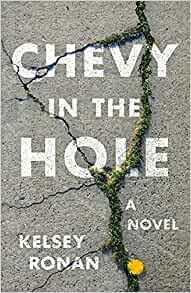By Bob Campbell
Reading Chevy in the Hole, the debut novel by Flint-native Kelsey Ronan, a question continued to nag me: What did Monae see in August that would allow such a relationship to take root?
He’s a nerdy, recovering drug addict who nearly died after overdosing in the bathroom of a Detroit farm-to-table restaurant and returned to his hometown of Flint to restart his life. She’s a senior “at the university” (UM-Flint, presumably) majoring in environmental science, volunteering at an urban farm in one of Flint’s many depleted neighborhoods and employed at Sloan Museum (the museum isn’t identified by name).
He’s also a habitual cigarette-smoker who crashes on his sister’s couch, doesn’t give a damn about much of anything, and is “pretty sure” Flint owes him something. Meanwhile, she’s motivated “to know why kids get fat on the free lunch program and the junk food their mothers buy at gas stations because they’ve got to take two buses to get to a supermarket.”
Oh, and then there’s this: In one of the nation’s most segregated communities and one with a checkered past and present on matters of race, he’s a 26-year-old white man and she’s a 22-year-old Black woman.

Chevy in the Hole cover – a novel by Kelsey Ronan.
Their bond is central to August’s salvation, Monae’s quest to rescue her father’s memory, and is something of an allegory for Flint’s gradual transformation in this thoughtful and fascinating place-based novel. Flint looms large in the story to point that it almost feels like a main character with a distinct personality instead of serving as the primary setting
However, as author Morgan Thomas states in the recent essay “Place is Not a Character—It is Its Own Story,“ “Rendering these aspects of place successfully on the page requires recognizing place not as backdrop or character, but as ecosystem—a system of interactions between living organisms and their environment, which leaves physical traces. … This is place—sentient, determining, the ecology with which other beings in our stories co-create their lives.”
August and Monae begin to co-create their lives together in 2014 after “the emergency financial manager (EFM), installed by the governor to pull the city out of debt and dysfunction, decided to pull drinking water from the Flint River instead of piping it in from Lake Huron.” By the time the novel concludes eight years later in 2022, August and Monae will have been swept along – Flint and its residents, too – by the full-blown public health crisis and its aftermath related to the city’s tainted drinking water.
Over the course of 285 pages, Ronan beautifully captures the mood and spirit of the period. Her descriptions of the desolation mixed with the rebirth of certain areas, along with the sounds and smells life in Flint, are spot on. Also noteworthy is the way she depicts the mixed emotions some residents feel about the way the city’s automotive heritage is remembered.
While he talked, Monae glazed a semi-smile on her face and stared out at Saginaw Street. Across from the wine bar were statues of David Dunbar Buick and Louis Chevrolet and Billy Durant, fathers of Flint’s auto industry; the city had recently erected them in baffling nostalgia. In the waning day, still threatening rain, they looked like loiterers on the sidewalk, no place to go.
Chevy in the Hole also traverses 85 years of Flint history where members of the respective families of August and Monae are participants in pivotal and notable events, a treatment reminiscent of the movie Forrest Gump. The episodes include the 1936-37 Sit-Down Strike, the horrific 1953 Beecher tornado, the Flint City Hall sleep-in to protest racial discrimination in housing, and the AutoWorld debacle.
Historical figures who appear include an elderly and broke Billy Durant, who was by then running a bowling alley in town; Flint’s first Black mayor Floyd McCree; and Keith Moon, The Who drummer who infamously decided to park a Cadillac in a swimming pool at the Holiday Inn on Bristol Road across from GM’s Flint Metal Fab after a concert earlier that evening. The number of historical interludes interspersed throughout the narrative felt, at times, like some heavy-duty name-dropping, at least for this Flint native. However, the story doesn’t bog down and keeps flowing. Moreover, a non-native reader might be rather surprised to learn about some of Flint’s sociocultural impact and stature pre-Roger & Me.
A few minor quibbles: In a chapter set in 1945, August’s then-young grandfather is described as having “pedaled past the smokestacked acres of Buick City.” This has become a common error, even among some Flint residents. The name “Buick City” wasn’t coined until the mid-1980s following a major GM reorganization. Prior the that, the massive industrial complex was the Buick Motor Division, headquartered in Flint. Also, given the novel’s long sweep of time, a family-tree diagram at the beginning the book – like Gabriel Garcia Marquez’s classic One Hundred Years of Solitude – would have been a helpful reference guide to keep of track August and Monae’s family ties going back generations.
So, what about Monae’s attraction to that burnout, August? That’s what I found most intriguing about the novel. While she is dismissive, even resentful of the nostalgic fervor for the city’s automotive heritage, this “young Black girl … with high cheekbones and braids” seems largely disconnected from contemporary Black Flint. That seems a bit odd for this child of the city’s Northside, given her family history, passion for improving healthy food options for the city’s children (who are predominately Black) and the close relationship with her Uncle Harold, a Third Ward (Third World?) councilperson and twice-defeated mayoral candidate.
But the same might be said of August’s disaffection and tenuous connection to white Flint.
Perhaps what August and Monae saw in each other might best be found at Chevy in the Hole – A clear lunar landscape, empty, stretching all the way downtown. As a speaker at a meeting of Narcotics Anonymous explained:
I mean, they’ve planted a thousand trees in Chevy in the Hole. Ain’t even Chevy in the Hole anymore. Chevy Commons, they’re calling it. We’re living in a whole other city. A whole new place.

Ronan, Kelsey. Chevy in the Hole. New York: Henry Holt and Company, 2022.
Preorder available for March 15 release.
Bob Campbell is a local writer. His debut novel Motown Man was published by Urban Farmhouse Press in November 2020.


You must be logged in to post a comment.